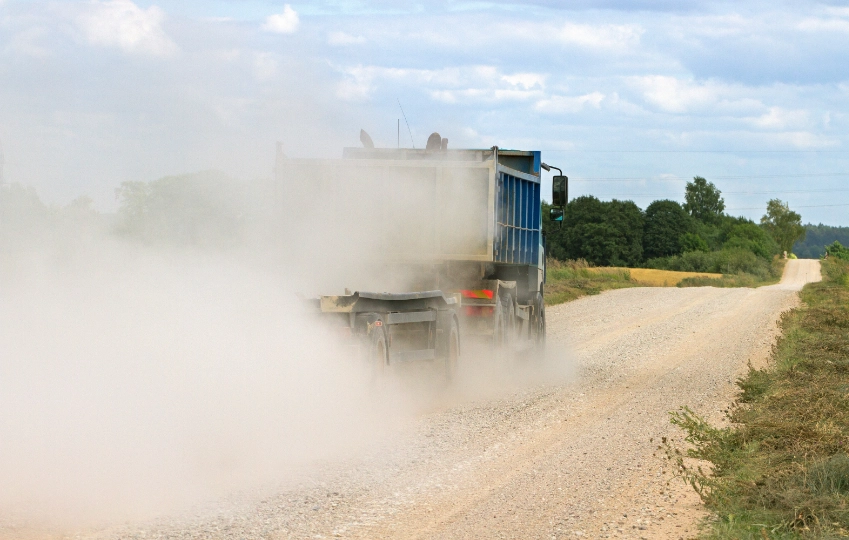May 2024

Gravel roads and dusty work environments pose significant challenges. The constant movement of vehicles and machinery stirs up fine particles, creating clouds of dust that not only obscure visibility but also impact health and safety. To combat this issue, many industries turn to dust suppression products. Let us explore the options available for long-lasting results.
Fugitive dust is small airborne particles created in many industries, including construction sites, land reclamation, unpaved roads, mining, and quarries. These fine dust particles remain suspended in the air for extended periods, creating harmful effects on air quality, driving, and visibility and posing health risks.
Workers exposed to dust on the job are at elevated risk of health issues. A study of 207 workers revealed that 110 reported at least one respiratory symptom, including coughing, breathlessness, and chest tightness[1]. The severity of the health impact increases with more prolonged exposure to the dust particles, both in the short and long term.
To protect workers' health and safety, OSHA has established regulations requiring employers to take effective dust control measures. Following the rules is mandatory, and failing to comply can result in hefty fines.
To effectively control dust, it is important to use a dust suppressant. Not all products are equal, so choosing the right one for your needs is crucial.
Solid solutions are available for dust control. The most common solutions are magnesium chloride flakes and calcium chloride flakes. Like dry salt, flakes are easily blown off surfaces and end up in the surrounding environment before they activate. This can result in wastage of the product, which, in turn, requires more frequent applications to maintain the desired level of dust control. Once the flakes blow off into the environment, it becomes a lost resource, costing you more money and time. Flake products are sold in bulk totes which can provide handling issues. Magnesium flakes work well in certain environments, like horse arenas. The flakes are contained where they are applied so not lost to blow off and are the preferred chloride as calcium chloride causes irritation to the horses. Solids are not the most effective solution for an outdoor long-lasting, cost-effective dust suppressant.
One commonly used solution to suppress dust is water. At first glance, it seems like an affordable, accessible, and simple method. However, despite its popularity, it does not offer longevity in controlling dust.
The primary limitation of using water as a dust suppressant is that it only provides a temporary, short-term solution. The water dries quickly on the surface, leaving once-treated areas ineffective. This presents issues in areas where fugitive dust is released repeatedly. In such settings, a long-term solution is critical to minimize the adverse impacts of dust on workers' health.
To act as an effective road dust suppression, light and frequent applications are needed. However, this requires using staggering volumes of water, and dedicated staffing to manage the application. While water itself may be inexpensive, using it as a dust suppressant solution can be more costly compared to other methods. This is due to its ineffectiveness, labour-intensive nature, and wastage of water resources.

Alternatively, dust suppressant liquids like magnesium chloride and calcium chloride act as two highly effective road dust suppression products. They are often referred to in conjunction as they have similar properties, though sold in different concentrations. Magnesium chloride for dust control sells at a 30% concentration, and calcium chloride for dust control sells at 35%. One gallon of calcium chloride is equal to one gallon of magnesium chloride based on the amount of active ingredient. In terms of performance gallon to gallon they are considered equal.
Liquid magnesium chloride and calcium chloride reduce dust and prolong the life of your surfaces. Both road suppression chemicals are hygroscopic compounds that pull moisture from the surrounding environment and provide a solution that keeps surfaces bound together, holding dust particles in place for much longer than a water solution. Liquid magnesium chloride can provide you with a dust suppressant solution that you only need to apply once, with a half rate touch up later in the season.
Research has shown that using a solution of calcium chloride or magnesium chloride liquid instead of traditional solids can reduce dust suppression products' cost and environmental impact by up to 50%. Using these solutions, we can effectively reduce the amount of chemicals released into the environment while saving money on annual dust control products expenses[2].
When deciding between magnesium chloride and calcium chloride for dust suppressants, consider availability, economics, and compatibility with your winter program. To learn more about dust suppressant products, visit Innovative Surface Solutions' website at https://www.innovativecompany.com/dust-control-solutions.php.
References
1 Saleiro, Sandra et al. “Occupational exposure to dust: an underestimated health risk?.” Jornal
brasileiro de pneumologia : publicacao oficial da Sociedade Brasileira de Pneumologia e Tisilogia
vol. 45,4 e20170396. 5 Sep. 2019, doi:10.1590/1806-3713/e20170396
2 Edvardsson, K. (2010). Evaluation of dust suppressants for gravel roads: Methods development and
efficiency studies
3 Source: Effectiveness and Environmental Impact of Road Dust Suppressants Jonathan Q. Addo and
Thomas G. Sanders, PH.D Department of Civil Engineering Colorado State University Ft. Collins, CO
80523
May 2024
April 2024
February 2024